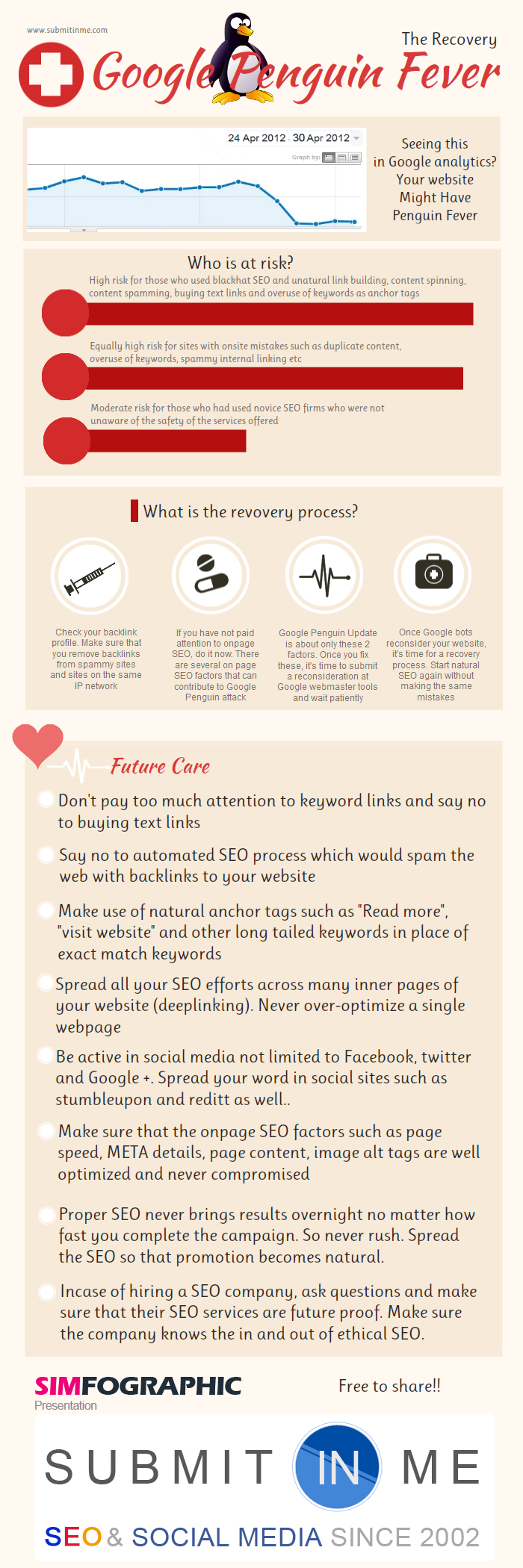
How To Recover From Google Penguin Penalty
In April 2012, Google made good its promise of improving the quality of contents on the web by rolling out the Google Penguin algorithm update, which was designed to fight spamming on the web. Behold, many websites suffered from the Google Penguin Penalty, which downgrades the page ranking of these sites. Thus, the Google Penguin Penalty led to the emergence of a new SEO disease, ‘the Google Penguin Fever.’ While some websites are still struggling to recover from this fever, others have not recovered at all. So how does one contact the Google Penguin Fever and what damages can be done to a website by this SEO disease?
The causes of Google Penguin Fever are numerous. However, websites that utilize blackhat SEO techniques for its SEO campaign are highly prone to this SEO fever. Blackhat SEO techniques like content spamming, content spinning, unnatural link building, overuse of keywords on anchor tags, and buying of textlinks increase a website’s risk of contracting the Google Penguin Fever. Also common on-page SEO mistakes can equally increase the odds of a website being infected with this SEO fever.
The Google Penguin Fever can really hurt a website badly. This SEO fever really hits websites where it hurts the most; It drastically bring down the page ranking of website. Since search engines drive the most traffic to a website, it is very important for a website to have a high page ranking in search engines. A high page ranking gives a website wide presence on the web, making it possible to reach out to its target audience. By sinking down the website page ranking, the Google Penguin fever is delivering a serious blow to the website’s online visibility.
The Road To Recovery from Google Penguin Fever
Well, the good news for webmasters is that their websites can recover from the Google Penguin Fever. With a change of approach in their SEO strategy and a lot of patience, webmasters can get their site on the road to recovery from this SEO fever. Below are some tips webmasters can use not only to get their websites back to the good book of Google but also to get their websites moving in the upward direction of the page rank chart:
Removal of Low-quality Backlinks
To kickstart the recovery process from Google Penguin Fever, webmasters need to analyze the backlink profile of their website. Websites with low-quality backlinks are prone to be infected by this SEO fever. Therefore, low-quality backlinks such as those coming from spammy sites and websites sharing the same IP network should be removed. Only high-quality backlinks put a website in a strong position to avoid this SEO fever.
Use High-quality On-page SEO Strategies
On-page SEO strategies that deploy the use of spam contents, spun contents, and one-phrase keyword anchor texts contribute highly to a Google Penguin Fever attack. Therefore, webmasters should replace such kind of on-page SEO strategies with strategies that make use of unique contents and multiple-phrased keyword anchor texts.
After effecting the above SEO changes on their website, webmasters should apply for reconsideration using the Google webmaster tools and wait patiently. Once their site has been considered by the Google bot, webmasters can start building up their website’s page ranking again with the techniques used to recover from the Google Penguin Fever attack.
Although millions of people visit Brandon's blog each month, his path to success was not easy. Go here to read his incredible story, "From Disabled and $500k in Debt to a Pro Blogger with 5 Million Monthly Visitors." If you want to send Brandon a quick message, then visit his contact page here.
